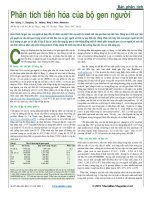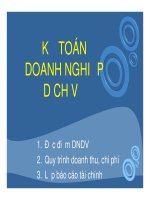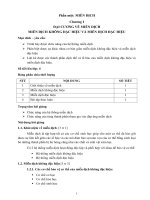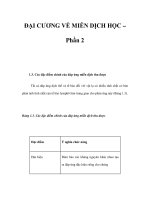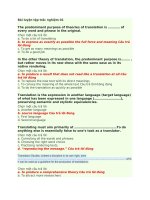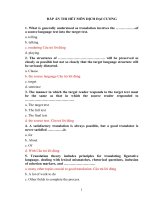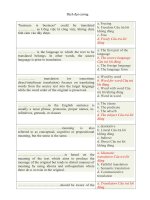Dịch Đại cương en42
Bạn đang xem bản rút gọn của tài liệu. Xem và tải ngay bản đầy đủ của tài liệu tại đây (240.72 KB, 88 trang )
<span class="text_page_counter">Trang 1</span><div class="page_container" data-page="1">
ĐÁP ÁN TRẮC NGHIỆM DỊCH ĐẠI CƯƠNG EN42_THI TRẮC NGHIỆMGhi chú (Đ) là đáp án đúng
Có bản dịch tiếng việt ở cuối tài liệu
Translation is the expression in another language (target language) of what has been expressed in one language (………), preserving semantic and stylistic equivalencies.
a. Another languageb. First languagec. source language (Đ)d. Second language
...meaning is also referred to as conceptual, cognitive or propositional meaning, but the sense is the same.
a. Indirectb. Directc. denotative (Đ)d. Literal
“business is business” could be translated …………... as Công việc là cơng việc, khơng chen tình cảm vào đây được.
a. Freeb. Freeingc. Freedomd. Freely (Đ)
“How” refers to whether the text is written in a formal or …………way which is influenced by the content of theoriginal text, by the situation of context
a. Niceb. Positivec. Goodd. Informal (Đ)
………..in the English sentence is usually a noun phrase, pronouns, proper names, to-infinitives, gerunds, or clauses
a. The adverbb. The predicatec. The claused. The subject (Đ)
</div><span class="text_page_counter">Trang 2</span><div class="page_container" data-page="2">……….should be aware of the concepts muli-words convey and the rules how to make and write compound words in English.
a. Teachersb. Workersc. Translators (Đ)d. Doctors
Q7.
Câu 7………….is based on the meaning of the text which aims to produce the message of the original but tends to distort nuances of meaning by using idioms and colloquialism where there do not exist in the original.a. Faithful translation
b. Communicative translationc. Idiomatic translation (Đ)d. Semantic translation
Q10.
Câu 10………to whom the translated text is addressed are native or non-native users of the target language.a. The interpreters
b. The translatorsc. The readers (Đ)d. The reporters
</div><span class="text_page_counter">Trang 3</span><div class="page_container" data-page="3">c. Was saidd. Were said
A sentence is a group of words conveying a complete idea which normally contain a subject and a verb predicate………...
a. In good formsb. in “finite” forms (Đ)c. In various formsd. In negative forms
A text could be translated into anything, ranging from one sentence to usually one third of the ………length, depending on specific situations.
a. original (Đ)b. Originc. Originated. Origination
</div><span class="text_page_counter">Trang 4</span><div class="page_container" data-page="4">Adaptation translation aims to create an equivalence of ………….…. applicable to a different situation than that of the source language.
a. The same methodb. the same value (Đ)c. The same thingd. The same way.
He or she reformulates the translation according to the grammar rules, ……….., cultural norms in the targetlanguage.
a. word usingb. word usec. word to used. word usage (Đ)
As for noun phrases (NP), the noun (common noun: love, proper noun: Mai, and pronoun: you) is ………of the phrase.
a. Armb. Handc. Head (Đ)d. Leg
As for noun phrases (NP), the noun (common noun: love, proper noun: Mai, and pronoun: you) is ………of the phrase.
a. Head (Đ)
</div><span class="text_page_counter">Trang 5</span><div class="page_container" data-page="5">b. Legc. Handd. Arm
As indicated by the word “free”, free translation (sometimes dynamic translation) focuses more ……..………..than form in the target language
a. On structuresb. On wordsc. on content (Đ)d. On meanings
At the beginning of the 1970s, the focus shifted from the word or phrase …………..the text as a unit of translation.
a. To (Đ)b. Forc. Atd. With
Certain strategies ……… those differences; for example, certain expressions or key terms in their to-be need to be selected.
text-a. Dealingb. To dealc. Dealing withd. to deal with (Đ)
</div><span class="text_page_counter">Trang 6</span><div class="page_container" data-page="6">Coordinating conjunctions are only in mid-position whereas ………conjunctions can be in initial or mid-position in the sentence.
a. Subordinating (Đ)b. subordinatec. Subordinatived. Subordination
Different strategies or different methods of translation produce ………. kinds of translation.a. Different (Đ)
b. Differencec. Differd. differently
During preparations for simultaneous ………….., the interpreters’ booth, if not fixed, should be positioned so that the interpreters can see the speakers.
a. Interpretedb. Interpretec. Interpretingd. Interpretation (Đ)
English prepositions are usually single words in, at, on...; …………, there are some prepositions that look like a phrase, phrasal prepositions: because of, in spite of...
a. Further moreb. More overc. Additionallyd. However (Đ)
English vocabulary mostly consists in single words, but ………...of multiword vocabulary is not small.a. The number
b. the amount (Đ)c. The figured. The fact
</div><span class="text_page_counter">Trang 7</span><div class="page_container" data-page="7">c. are crucial (Đ)d. is crucial
Faced by a text in a language, as student translators, you should analyze the text by asking and ………. several questions.
a. Answering (Đ)b. Tobe answeredc. To be answeringd. Answered
Figurative meaning is based on or makes use of figures of ……...such as metaphor (an implied comparison between two things with the same characteristic.
a. Speech (Đ)b. speakc. Listeningd. Writing
For simultaneous interpretation, microphones, earphones and a booth are necessary ……….a. Domestic tools
b. Machinesc. Electrical devicesd. technical equipment. (Đ)
Gist translation can be used in language learning situations (using the same language) ………at a written testa. to consider a written text
b. to write a written text
c. to summarize a written text (Đ)d. to correct a written text
Q39.
Câu 38He or she reformulates the translation according to the grammar rules, ……….., cultural norms in the targetlanguage.
</div><span class="text_page_counter">Trang 8</span><div class="page_container" data-page="8">b. word usingc. word to used. word use
Q40.
Câu 39Idiomatic translation can be applied to the English sentence that describes the degree of the sameness of the two girls’ appearance “ They look ………….. the same” (Chúng giống nhau như hai giọt nước).
a. Exactingb. Exactly (Đ)c. Exactnessd. Exact
Q41.
Câu 40If any key words are ……….., the text will need to be checked carefully for consistency in the change made.
a. Changingb. Changed (Đ)c. Changed. To change
If any key words are changed, the text will need to be checked carefully for consistency in the change……….
a. Is makingb. Being madec. made. (Đ)d. Making
In ………..the form of the source language is replaced by the form of the receptor/target language.
a. Transliterationb. Translatingc. translated
</div><span class="text_page_counter">Trang 9</span><div class="page_container" data-page="9">Q46.
Câu 45In English, the ……….. phrase can be used after a verb, an adjective, or a noun and depend on them.a. preposition
b. prepositionsc. Prepositional (Đ)d. prepositionally
Q48.
Câu 47In English-Vietnamese translation of the predicate verb, the meanings of time and aspect can ………to such words as đã, sẽ, sắp, đang...
a. Correspond (Đ)b. Go
c. Suitabled. Respond
Q50.
Câu 49In the history of translation development there have been a great number of terms: literal, free, literary, literary, borrowing, equivalence, figurative, so on ……….
non-a. And so far
</div><span class="text_page_counter">Trang 10</span><div class="page_container" data-page="10">c. and so forth. (Đ)d. And so long
Q51.
Câu 50In the other theory of translation, the predominant purpose is……… , but rather moves in its new dress with the same ease as in its native rendering.
a. To do the translation as quickly as possible
b. to produce a result that does not read like a translation at all (Đ)c. To convey the meaning of the whole text
d. To replace the new text with its direct meanings
Q52.
Câu 51In this situation the translator’s task is recreate some form of language ………. the same meaning.a.to convey (Đ)
b.To changec.To correctd.To follow
Q53.
Câu 52In word formation, morphemes which occur at the front of a word are called ……….a. prefixes (Đ)
b. Inflectionalc. Suffixesd. root.
It can be said that language cannot exist without words. Word ……….is the reflection of human perception of the world.
a. Combinationb. formimgc. Changing
</div><span class="text_page_counter">Trang 11</span><div class="page_container" data-page="11">Q57.
Câu 56It is also very useful for the translator ………and analyze the original text before translating it into the target language.
a.Understandingb.Undertoodc.to understandingd.to understand (Đ)
Q59.
Câu 58Mastery of the source language is a ……….for the translator, since this mastery is the key to his/her readings and interpretations of the text to be translated.
a. Couldb. Canc. Must (Đ)d. May
Q60.
Câu 59Polysemes can be compared with homonyms, which are words with several ………meaningsa. Popular
b. Commonc. Unrelated (Đ)d. Direct
Q61.
Câu 60Practically, whether
………is termed as ‘Translation Theory’ or ‘Translation Studies’ it culminates with the theory on proper principles of translation.
</div><span class="text_page_counter">Trang 12</span><div class="page_container" data-page="12">b. The usefulness of translationc. The interest in translationd. The practice of translation
Q62.
Câu 61Remember that all of our verbalizing must be done in the target language now. We must ………..between alternatives and produce a text that is sequentially complete.a. Choosing
b. Choose (Đ)c.
Q65.
Câu 64Since figurative language is not intended to be interpreted in a literal sense, in ……… figurative language, translators should make use of comparison between different things
a. Translateb. translationc. Translatedd. Translating (Đ)
Q66.
Câu 65Since the mid-1970s the name ‘Translation Studies’ has been adopted to indicate that the ………….is not just a minor branch of comparative literary study, nor yet a specific area of linguistics, but a vastly complex field .a. Way of translating
b. Field of translationc. study of translation (Đ)d. Method of translation
</div><span class="text_page_counter">Trang 13</span><div class="page_container" data-page="13">Q67.
Câu 66Syntactical forms which …………. used to express grammatical meanings of the verb in English sentences are obligatory,
a. are (Đ)b. Has beenc. beend. Is
Q68.
Câu 67The ... of words in Vietnamese does not seem to be so distinctive: word classes do not have their typical forms, their forms never change in the sentence.
a. classb. Classes
c. Classification (Đ)d. Classify
The ……….in the English sentence usually stands right after the subject, giving information about the subject.
a.Verb formb.Verb patternsc.Verb phrased.verb predicate (Đ)
</div><span class="text_page_counter">Trang 14</span><div class="page_container" data-page="14">c. Whend. Which (Đ)
The first step in the analysis of words is to determine whether the word is referring primarily to a thing concept,……….. event concept, an attribute concept, or a relation concept.
a. an (Đ)b. Zeroc. thed. A
The forms are ……… to as the surface structure of a language.a. Referred (Đ)
b. referc. Referenced. Referring
The instructor can then hope to measure the students’ linguistic competence by ..………
a. Asking some questions
b. Encouraging them to work morec. Practising more and more
d. means of the target language products.(Đ)
The language of translation is ………. from the translated text, reflecting the translator's interpretations, the translator's strategies and the translator's abilities.
a. Haveb. Takec. Get
</div><span class="text_page_counter">Trang 15</span><div class="page_container" data-page="15">The linguistic approaches basically ……….. translating as a code-switching operation.a. Seeing
b. Saw (Đ)c. seend. Sees
The meaning of words are translated almost as ……… as those in the target language without paying attention to the situation or context
a. Closingb. closec. Closenessd. closely (Đ)
The number of words and the sentence length may vary, depending on the ………of the translator when he/she adds explanations or comments to make clear the meaning of the original.
a. Complementb. Object
c. Subjectivity (Đ)d. Subject
The predominant purpose of theories of translation is ……… of every word and phrase in the original.a. To do a good job
b. To do a lot of translating
c. To get as many meanings as possible
d. to express as exactly as possible the full force and meaning (Đ)
The presentation here is conducted in a systematic manner with ……….. restricted interactivity and closeness and much faster than consecutive interpretation.
a. Somewhichb. Somewhat (Đ)
</div><span class="text_page_counter">Trang 16</span><div class="page_container" data-page="16">The sentence is structurally made up of a group of words which has subject and ………..as indispensible elements; the complement, object and adverbial are optional:
a. verb patternsb. Verb formc. Verb phrased. verb predicate (Đ)
The source language, as has been seen earlier, is not only the very central and initial point for the ……….ofthe translation process but also is the background for all translation processes.
a. Startingb. startedc. To startd. Start (Đ)
The source text is the text which has been chosen for translation. The translator cannot, without a good reason, change any………..
a. Topic of the text
b. part of the source text. (Đ)c. Meaning of the textd. Element of the text
The source-language content, form, style, function, etc. must be preserved, or at least that the translation must seek ……...…them as far as possible.
a. preservationb. to preserve (Đ)c. Preservingd. Preserve
</div><span class="text_page_counter">Trang 17</span><div class="page_container" data-page="17">The stage of editing the translated text which ………. the form of a careful last-minute checking and correcting of possible mistakes or other inaccuracies is implemented in most cases of translation.
a. Takenb. Tookc. takes (Đ)d. Taking
The target language is the language into which ………from another language is translated.a. A document
b. A paperc. a text (Đ)d. A report
The three elements of source language, source text, and translator, theoretically and ……….……… precede the translated text.
a. Practicalb. Practisec. practiced. Practically (Đ)
The translated text is the actual definite material, …………has been produced by conveying the meaning of a source text in terms of another language and culture.
a. When
</div><span class="text_page_counter">Trang 18</span><div class="page_container" data-page="18">c. Whered. Which (Đ)
The translator begins drafting the translation piece by piece, section ………by using the lexis and structures
a. by section (Đ)b. By stepc. By sentenced. By phrase
The translator discovers the meaning behind the forms in the source language and does his best to produce the same meaning ……….
……….a. in the source language
b. Out of the source textc. in the target language (Đ)d. Outside the source text
The translator has to think over his/her translation to suit a reader according to the reader’s social norms in the target language, so the language of translation is …………
a. Commonb. Privatec. Personald. social. (Đ)
The translator is the initial knower of two languages, or more, who ………..the ability to move between twolanguages.
a. Hadb. Has (Đ)c. have
</div><span class="text_page_counter">Trang 19</span><div class="page_container" data-page="19">The translator should examine his reasons for choosing the text and the potential for its use by the ……….audience.
a. Received languageb. Receiving languagec. Receptor language (Đ)d. Receiver language
The translator should remember ………. the zero article with plural count nouns in English to mean generally
a. to use (Đ)b. Usec. Usingd. Usage
The translator tries to come as close as possible to the meaning conveyed by the words, by means of word order change or word choice so that the true meaning is……….
a. Usedb. Checkedc. conveyed. (Đ)d. done
The translator, like the linguist who …………..all human languages to be on an equal footing, is among the first candidate to be liberated from the dominance of one language/culture
</div><span class="text_page_counter">Trang 20</span><div class="page_container" data-page="20">b. tookc. takingd. takes (Đ)
The translator's judgments, strategies and manipulations ………all potentially exist in the translator's interpretation of the source text and the formulation of the translated text which is governed by the target language.
a. Do (Đ)b. Doesc. Doned. Did
There are a variety of cultural elements to take into ………..when starting a translation.
a. Consideredb. consideration (Đ)c. Consider .d. Considering
there is a skewing between the semantic classification ……… the grammatical classification. Some words are made up of more than one concept.
a. butb. And (Đ)c. nord. Or
There is any place where information has been added, omitted, or subtracteda. Substract
b. subtractingc. subtracted (Đ)
</div><span class="text_page_counter">Trang 21</span><div class="page_container" data-page="21">There is some unusuality or ………. in the target language.a. Nature
b. Unnaturalness (Đ)c. Natural
Things are defined as all animate beings and all inanimate entities. Events include all actions, processes, ……….. experiences.
a. And (Đ)b. Norc. Sod. For
This means that the translator has, ……….the pressure of deadlines, more time than the interpreter (especially the simultaneous interpreter) to process the source text thoroughly .
a. Despite (Đ)b. thoughc. In spited. although
</div><span class="text_page_counter">Trang 22</span><div class="page_container" data-page="22">to translate means “………... a text in a target setting for a target purpose and target addresses in target circumstances".
a. to produce (Đ)b. To correctc. To getd. To arrange
Today, roughly speaking, three ……….of interpreting are practiced: liaison, consecutive and simultaneous interpreting.
a. stepsb. sensesc. Forms (Đ)d. Speeds
Translating may be defined as the process of ………signs or representations into other signs or representations.
a. transformerb. Transformedc. Transformationd. Transforming (Đ)
Translation is rendering a written text into another language in a way that the ……….. intended the text.a. Secretary
b. Musicianc. Author (Đ)d. Worker
Translation is the ………. of a representation of a text in one language by a representation of an equivalent text in a second language.
a. Replacement (Đ)b. Replacedc. Replacingd. Replaceable
</div><span class="text_page_counter">Trang 23</span><div class="page_container" data-page="23">b. Only the best meanings of the textsc. semantic and stylistic equivalencies. (Đ)
d. The simplest form of the language in communication
Translation should ensure that the ………meaning of the two will be approximately similar.a. surface (Đ)
b. differentc. indirectd. abstract
a. Causesb. Reasonsc. Resultsd. Principles (Đ)
</div><span class="text_page_counter">Trang 24</span><div class="page_container" data-page="24">Translation theory includes principles for translating figurative language, dealing with lexical mismatches, rhetorical questions, inclusion of cohesion markers, and ………
a. A lot of work to do
b. Other fields to complete the process.
c. many other topics crucial to good translation. (Đ)d. To give translator a chance
Translation, by dictionary definition, consists of changing from one state or form to another, to turn into ………or another’s language.
a. His ownb. Their ownc. one’s own (Đ)d. Her own
Translator need revise the draft on the basis of the feedback received from those people who may have suggestedmany………., changes, additions or omissions with the translator.
a. Rewordings (Đ)b. Rewritec. Rewordedd. Rewriting
Translators have to make sure that they ……….a text well in the original languagea. understand (Đ)
b. Understandingc. To understandd. Understood
Translators should define both subject and verb predicate at ……….. time if they want to translate a sentence.
a. The bigb. The goodc. The niced. the same (Đ)
Translators should define proper verbs of English to go with the subject, either ……….: be, get, become... or action/dynamic verbs run, work... to follow the subject.
a. Mono-transitive verbs
</div><span class="text_page_counter">Trang 25</span><div class="page_container" data-page="25">b. linking/static verbs (Đ)c. di-transitive verbsd. Transitive verbs
Translators should rely on the context to select the right word; in ………about which word to be used, they could consult a dictionary of synonyms and antonyms or any thesaurus for help.
a. field of doubtb. way of doubtc. case of doubt (Đ)d. example of doubt
Translators should use procedures of transposition to render from the Source Language texts ………..as to suit the Target Language grammar rules.
a. in such a wayb. in such ways (Đ)c. in several waysd. in many ways
What is generally understood as translation involves the ………..of a source language text into the target text.
a. playingb. tellingc. rendering (Đ)d. talking
What the interpreter is unable to grasp in his first and only confrontation with the text is ……….forever.a. disappeared
b. losec. Losingd. Lost (Đ)
when meeting for the first time, ………..when introduced to a guest, English people often say: How do you do? as a greeting
a. Especially (Đ)b. Specializationc. speciald. specially
</div><span class="text_page_counter">Trang 26</span><div class="page_container" data-page="26">whereas the interpreter is faced with a unique, orally delivered text, the translator has ………of "flicking back" through the permanently available written text.
a. the possibility (Đ)b. The difficultyc. The pleasured. The happiness
Translation has become popular in language learning and daily life. So far, there have been ………definitions of translation.
a. 20b. many (Đ)c. 18d. 17
</div><span class="text_page_counter">Trang 27</span><div class="page_container" data-page="27">b. Interpreting the talksc. interpret them directly. (Đ)d. Translate all the things
……….is the interpreter of the source text, and the producer of the final interpretation which determines the meaning(s) which readers of the translation will read.
a. The reseacherb. The teacherc. The translator (Đ)d. The writer
………..is characterized by keeping the main idea/gist of a text, omitting all of its supporting details and subsidiary arguments.
a. Literal translationb. Gist translation (Đ)c. Free translation
However, grammatical words in general and articles and prepositions in ………..might cause headache totranslators.
a. deedb. Timec. particular (Đ)d. fact
When analyzing the text for translation ……… the first time, the translator needs to find answers to thesequestions:
a. for (Đ)b. Underc. withd. in
</div><span class="text_page_counter">Trang 28</span><div class="page_container" data-page="28">The translators should read the text several times, then if possible read other materials that may help in understanding the culture or language of the ………
a. Languageb. source text (Đ)c. Paragraphd. Passage
The translator also has to solve, ………., matters involving text adjustments in terms of additions, omissions and adaptations.
a. Inside mindb. Within mindc. in mind (Đ)d. At mind
The translator should try ………..in the text those differences (usually by underlining) both in linguistic and cultural aspects between the source and target language
a. Foundb. To foundc. to find (Đ)d. Finding
</div><span class="text_page_counter">Trang 29</span><div class="page_container" data-page="29">b. source language c. First languaged. Second language
Translation has become popular in language learning and daily life. So far, there have been ………definitions of translation.
a. many b. 17c. 18d. 20
Since the mid-1970s the name ‘Translation Studies’ has been adopted to indicate that the …….
………is not just a minor branch of comparative literary study, nor yet a specific area of linguistics, but a vastly complex field .
a. Way of translatingb. study of translation c. Method of translationd. Field of translation
</div><span class="text_page_counter">Trang 30</span><div class="page_container" data-page="30">to translate means “……… a text in a target setting for a target purpose and target addresses in target circumstances”.
a. To arrangeb. to produce c. To get d. To correct
There is some unusuality or ……… in the target language.a. Nature
b. Naturalc. Unnaturalness d. unnatural
The forms are ……… to as the surface structure of a language.a. refer
b. Referred c. Referringd. Reference
Translation is the ………. of a representation of a text in one language by a representation of an equivalent text in a second language.
a. Replacedb. Replacement c. Replaceabled. Replacing
The linguistic approaches basically saw translating as ………a. An authentic way of expressing ideas.
b. a code-switching operation.
</div><span class="text_page_counter">Trang 31</span><div class="page_container" data-page="31">c. A good way of communicationd. A subject of study
Translation has become popular in language learning and daily life. So far, there have been many ………..……….. of translation,
a. definingb. definitionc. definitiond. definitions
Translation may be defined as follows: the replacement of textual material in one language (Source Ianguage.) by ………. in another language (Target Language).
a. equivalent clausesb. equivalent words c. equivalent material d. equivalent sentences
Translation theory includes ……….for translating figurative language, dealing with lexical mismatches, rhetorical questions, inclusion of cohesion markers, and many other topics crucial to good translation.
a. Principles b. Reasonsc. Resultsd. Causes
</div><span class="text_page_counter">Trang 32</span><div class="page_container" data-page="32">It is the structural part of language which is actually seen in print or heard in ………a. Spoke
b. Spokenc. Speech d. Speaking
There are a variety of cultural elements to take into………..when starting a translation.a. consideration
b. Consider .c. Consideredd. Considering
Translation is rendering a written text into another language in a way that the ……….. intended the text.a. Worker
b. Author c. Secretaryd. Musician
Translation it must be conceived as an integral communicative……….a. Performance
b. Performedc. performingd. Performative
The choice of the right word in the receptor language to translate a word in the source-language text depends more ………than upon a fixed system of verbal consistency.
a. At the context b. on the context c. About the source textd. With the meaning of the text
</div><span class="text_page_counter">Trang 33</span><div class="page_container" data-page="33">In ………..the form of the source language is replaced by the form of the receptor/target language.
a. Transliterationb. Translation c. translatedd. Translating
The source-language content, form, style, function, etc. must be preserved, or at least that the translation must seek ………….them as far as possible.
a. to preserve b. Preservec. Preservingd. preservation
At the beginning of the 1970s, the focus shifted from the word or phrase ……the text as a unit of translation.a. At
b. Forc. To d. With
</div><span class="text_page_counter">Trang 34</span><div class="page_container" data-page="34">c. The practice of translationd. The usefulness of translation
The linguistic approaches basically ……….. translating as a code-switching operation.a. Seeing
b. Seesc. Saw d. seen
Translation, by dictionary definition, consists of changing from one state or form to another, to turn into ………or another’s language.
a. Her ownb. His ownc. Their ownd. one’s own
Translating may be defined as the process of ………signs or representations into other signs or representations.
a. Transformedb. transformer c. Transforming d. Transformation
Translation theory includes principles for translating figurative language, dealing with lexical mismatches, rhetorical questions, inclusion of cohesion markers, and …
a. To give translator a chance
b. Other fields to complete the process.c. A lot of work to do
d. many other topics crucial to good translation.
The structures of ………. will be preserved as closely as possible but not so closely thatthe target language structure will be seriously distorted.
a. sentenceb. Clausec. target
d. the source language
</div><span class="text_page_counter">Trang 35</span><div class="page_container" data-page="35">A satisfactory translation is always possible, but a good translator is never satisfied ………it.a. With Câu
b. Aboutc. Ofd. for
The three elements of source language, source text, and translator, theoretically and ………. precede the translated text.
a. Practicalb. practicec. Practically d. Practise
The source language, as has been seen earlier, is not only the very central and initial point for the ……….ofthe translation process but also is the background for all translation processes.
a. Startingb. startedc. To startd. Start
This means that the translator has, ……….the pressure of deadlines, more time than the interpreter (especially the simultaneous interpreter) to process the source text thoroughly .
a. Despite
</div><span class="text_page_counter">Trang 36</span><div class="page_container" data-page="36">c. althoughd. though
…………sits next to or behind his “client” doing a great variety of activities under different names: “communityinterpreting”, “public service interpreting”, “hospital interpreting”, “mental health interpreting” and “social service interpreting”
a. The interpreter b. The editorc. The translatord. The analyste. The operator
The elements of translation interact as elements achieving one function, in ……each element relates to one or more of the rest.
a. Whatb. Which c. whod. When
The producer of the final interpretation ……… determines the meaning(s) which readers of the translation will read.
a. Whereb. Which c. Whend. What
The presentation here is conducted in a systematic manner with ……… restricted interactivity and closeness andmuch faster than consecutive interpretation.
a. Somewhenb. Somewhichc. Somewhat d. somewhere
</div><span class="text_page_counter">Trang 37</span><div class="page_container" data-page="37">d. The source text
During preparations for simultaneous……….., the interpreters’ booth, if not fixed, should be positioned so that the interpreters can see the speakers.
a. Interpreteb. Interpretedc. Interpretingd. Interpretation
Literal force is of course inevitably lost in these cases and the best that can be achieved is ……..to the pragmatic function of the TL cultural reference or practice.
a. by means of arrangementb. by means of faithfulness c. by means of correctiond. by means of cleanness
The source text is the text which has been chosen for translation. The translator cannot, without a good reason, change any………..
</div><span class="text_page_counter">Trang 38</span><div class="page_container" data-page="38">b. Meaning of the text Câu trả lời không đúngc. part of the source text.
d. Element of the text Câu trả lời không đúng
A Vietnamese-English translated text should follow the language rules………. social-cultural features of the English – not Vietnamese – language and vice versa.
a. and b. orc. Sod. but
For simultaneous interpretation, microphones, earphones and a booth are necessary ……….a. Machines
b. Electrical devicesc. Domestic toolsd. technical equipment.
To have interpretation as precise as possible, they should make regular shorter breaks to enable the interpreters ……….the message in the same spirit.
a. to relay b. To justifyc. To changed. To reproduce
The translator, like the linguist who …………..all human languages to be on an equal footing, is among the first candidate to be liberated from the dominance of one language/culture
a. tookb. takenc. takes d. taking
</div><span class="text_page_counter">Trang 39</span><div class="page_container" data-page="39">The language of translation is perceived from the translated text, ………the translator’s interpretations, the translator’s strategies and the translator’s abilities.
a. Understanding b. Interactingc. practisingd. reflecting
The translator’s judgments, strategies and manipulations ………all potentially exist in the translator’s interpretation of the source text and the formulation of the translated text which is governed by the target language.
a. Do b. Didc. Doesd. Done
The translator has to think over his/her translation to suit a reader according to the reader’s social norms in the target language, so the language of translation is …
a. Commonb. socialc. Privated. Personal
Mastery of the source language is a ……….for the translator, since this mastery is the key to his/her readings and interpretations of the text to be translated.
a. Couldb. Canc. Mayd. Must
The readers to whom the ……….. text is addressed are native or non-native users of the target language.
a. Translateb. Translated c. translatingd. translation
Today, roughly speaking, three ……….of interpreting are practiced: liaison, consecutive and simultaneous interpreting.
</div><span class="text_page_counter">Trang 40</span><div class="page_container" data-page="40">b. Speedsc. Forms d. steps
What the interpreter is unable to grasp in his first and only confrontation with the text is ……….forever.a. Losing
b. losec. Lost d. disappeared
whereas the interpreter is faced with a unique, orally delivered text, the translator has ………of “flicking back” through the permanently available written text.
a. The difficultyb. the possibility c. The pleasured. The happiness
The translator is supposed to be beyond the influences of the social and …………. environment of any of the two languages.
a. Cultivateb. Cultivationc. Cultured. Cultural
The target language is the language into which ………from another language is translated.a. A paper
b. A reportc. a text d. A document
The translated text is the actual definite material, …………has been produced by conveying the meaning of a source text in terms of another language and culture.
a. Which b. Wherec. Whatd. When
</div>